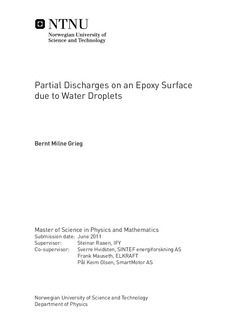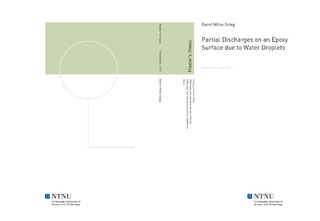Partial Discharges on an Epoxy Surface due to Water Droplets
| dc.contributor.advisor | Raaen, Steinar | |
| dc.contributor.advisor | Hvidsten, Sverre | |
| dc.contributor.advisor | Mauseth, Frank | |
| dc.contributor.advisor | Keim Olsen, Pål | |
| dc.contributor.author | Grieg, Bernt Milne | |
| dc.date.created | 2011-06-30 | |
| dc.date.issued | 2011 | |
| dc.identifier | ntnudaim:6603 | |
| dc.identifier.uri | http://hdl.handle.net/11250/2400638 | |
| dc.description.abstract | Offshore wind turbines are exposed to a very harsh environment and can sustain significant damage during operation. In this thesis work, the possibilities of partial discharges in an insulation system of an offshore wind turbine were investigated. The insulation system that was studied was a hybrid system. The system was made up of an epoxy filler and a shell made out of glass fiber enforced epoxy composite. In addition to these two epoxy components there was an oil component. It was this oil that was the main focus of this thesis. It was theorized that if the oil was allowed to diffuse into the glass fiber enforced epoxy composite surface it would change the aging situation. The validity of this theory was investigated with a series of experiments and simulations. The experiments were done in two parts. The first part was an investigation of the partial discharge situation for the system. The second was an aging test. The experiments were conducted on a test sample, designed to have a similar electrical situation as the turbine. In the partial discharge test water droplets were placed on the surface of the sample and different levels of high voltage were applied. Both deionized and salt water droplets were used. The aging tests were conducted at the voltage levels used in the turbine and at voltage levels were it was known that partial discharges occurred. In the aging test the test samples were periodically exposed to a continuous stream of salt water drops. For 16 h salt water was dripped onto the surface and allowed to flow down the width of it. After the 16 h the sample was left to dry for 8 h. This process was repeated over a period of several days. When the samples were saturated with oil the voltage level required to create discharges was reduced. In the cases were no oil was present there were no significant discharges recorded around the voltage levels expected in the turbine. For an oil saturated sample discharges were observed at voltage levels around those expected in the turbine. Further investigations are required in order to understand the reasons for these effects. | |
| dc.language | eng | |
| dc.publisher | NTNU | |
| dc.subject | Fysikk og matematikk, Teknisk fysikk | |
| dc.title | Partial Discharges on an Epoxy Surface due to Water Droplets | |
| dc.type | Master thesis |
Tilhørende fil(er)
Denne innførselen finnes i følgende samling(er)
-
Institutt for fysikk [2698]

